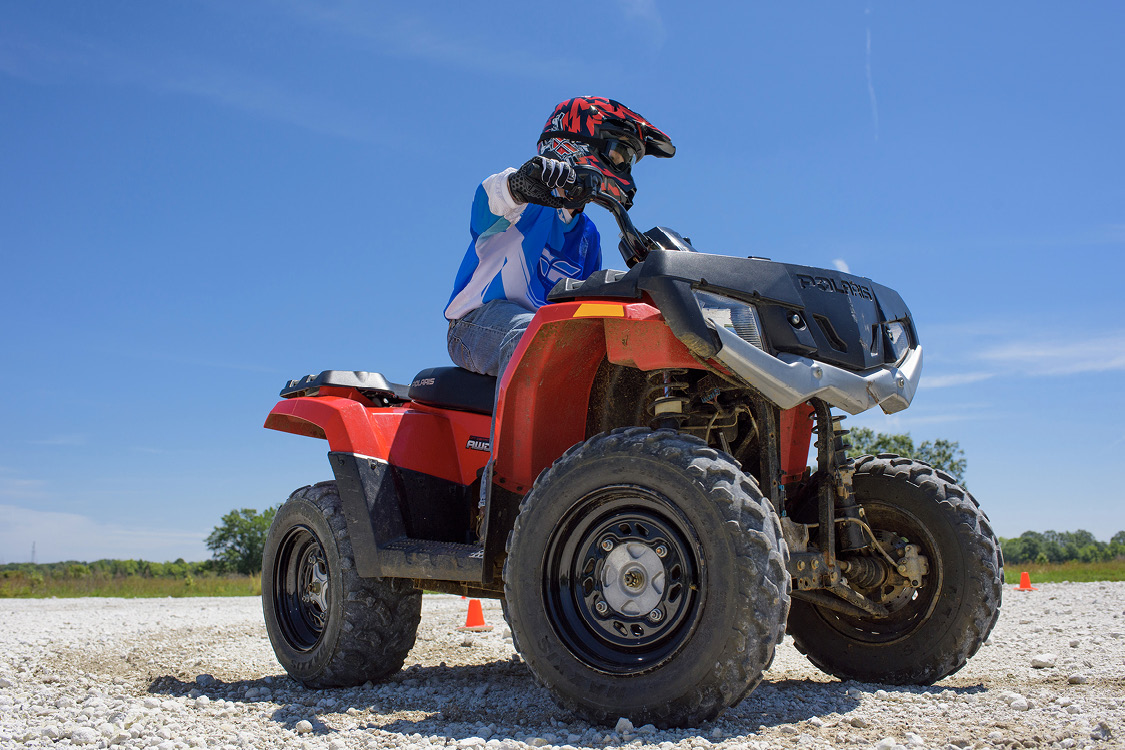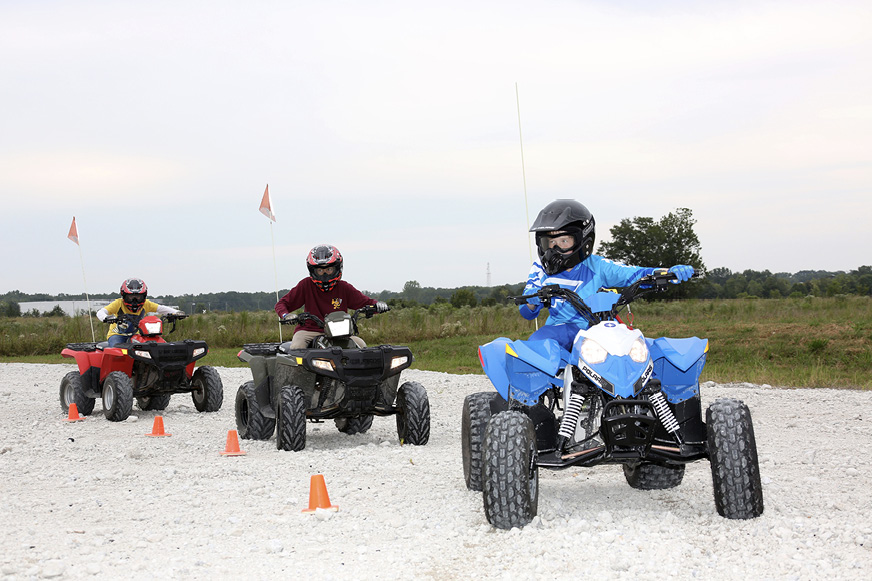Safe Riding Tips: 4-H ATV Safety

It’s a hot July day and you need to check some fences. Or it’s the first crisp day of autumn and a forest trail is calling. Whatever the reason, riding an all-terrain vehicle (ATV) can be rewarding and fun. But as a motorized machine with the power to go fast and climb high, an ATV must be respected and properly used.
Well-Trained Riders Keep Trails Safe
Millions of people use ATVs without incident. Some, however, don’t. Since 1985, the U.S. Consumer Product Safety Commission reports over 8,000 ATV-related deaths have occurred in the United States.* The under-16 age group has one of the highest numbers of estimated injuries. Youth riding adult ATVs, speed, unsafe driving conditions, and rider inexperience can combine to form a “perfect storm” for accidents. So how do you avoid mishaps? Education helps. Well-trained riders can better handle obstacles, trails, and their machines!
How to Have Fun, Get the Job Done, and Stay Safe
You want to ride ATVs safely. You’ve got zero tolerance for accidents. Here’s our top 10 safety tips:
1. Take a course, of course!
Before you start your engine, you need to get to know your machine and figure out how to ride it. Take a recognized ATV course such as the one offered by the ATV Safety Institute. It’s fun! You’ll learn how to start and stop (very important) and handle obstacles, while gaining other critical skills. Check out the ASI E-Course at www.atvsafety.org!
2. Age matters
Is it a good idea to drive a front-end loader by just jumping on and starting the engine? No! An ATV may not be as powerful, but it also needs an experienced, mature driver. Your ATV needs to fit you (see tip #10), but you also have to use good judgment to ride safely. If you’re under age 16, ride with an adult!
3. Wear a helmet
No, really, always wear a helmet. It should be specially approved for ATV use—don’t just grab your bicycle helmet. People who wear helmets have a better chance of avoiding head injuries. While you’re at it, wear eye protection, boots, gloves, and other riding gear.
4. Ride on unpaved trails
That’s right. Paved surfaces are for automobiles. Repeat: paved surfaces are for automobiles. And bicycles and skateboards and skates, but again, not for ATVs. ATV tires are actually made to grip dirt better. So stay on unpaved trails!
5. Ride without passengers
When you ride an ATV, you use your weight to balance and control the vehicle. If you’ve got a passenger, you can’t possibly know how they are going to move. Subtle shifts can cause you to lose control of the ATV. So ride alone. The only exception to this rule is a two-up, or tandem, ATV. A two-up can handle one rider and one passenger. On a two-up, never carry a passenger too small to firmly plant their feet on the footrests and securely grasp the hand holds. The passenger must always: Use a DOT-compliant or quality helmet and protective gear, securely grasp hand holds and plant feet firmly on footrests while seated in the passenger seat, tell the operator to slow down or stop if they are uncomfortable, and get off and walk if conditions require.
6. Be a control freak
Riding ATVs means you have to make adult-like decisions constantly. You have to keep your speed low enough to handle surprises (like darting squirrels). You have to decide not to leap before you look. (Your ATV has maximum control if its wheels are in contact with the ground.) Jumps, wheelies, and other stunts mean that fate is in control, not you.
7. Ride with a clear head
It takes a lot of skill to ride an ATV from point A to point B. If you ride while drinking alcohol or using drugs, you may never reach point B.
8. Know the terrain
If you ride the same trail over and over again, you probably know its turns and grooves like the back of your hand. Chances are, you don’t run into any surprises, and you can focus on the fun. If you try a new trail, scout it out first, looking for obstacles such as logs, drop-offs, and other dangers.
9. Know the rules!
Every state has different laws about where to ride, how old you must be to ride, and which type of training you need (and you do need training). Check these laws. Ignorance is no excuse!
10. Ride the right size machine!
It’s important that your ATV fits you like a glove. But how do you know if you’re riding a machine that’s too big or too small? Check out the following guidelines!
- Clearance between ATV seat and inseam while standing up on foot pegs. The minimum clearance between your ATV seat and inseam, while standing up on the foot pegs, should be 3 to 6 inches. This proper clearance lets you stand up and absorb shocks through your legs while riding on rough terrain. It minimizes the chance that your seat will hit you during a ride, throwing you over the handlebars. Proper clearance also improves your visibility and comfort.
- Upper legs. The upper portion of your leg, roughly from the top of the knee to the hip, should be about horizontal. A little above or below horizontal shouldn’t be a problem, but huge differences (knees jutting below or above the hips) should be checked by an adult. If your knees are quite a bit above your hips, turn the handlebars in both directions and check for contact with knees or legs. This important fit area helps keep you in control of your vehicle.
- Foot length. Place the heel of your right shoe against the foot peg or in the proper position on the running board. Your toe should be able to depress the footbrake with a simple downward rotation of your foot. Check for any contact with engine or exhaust protrusions. You should be able to use the brakes consistently without hesitation. (The same rule applies to the ATV’s left side, where the gearshift is located.) This allows you to keep control of your vehicle and braking.
- Grip reach. Sit normally on your ATV with your hands on the handlebars. Your elbows should have a distinct angle between your upper arm and forearm. If your elbows are straight, you won’t be able to turn the handlebars. Make sure you aren’t leaning forward to compensate for a short reach. If your elbows are at less than right angles, you are too large for the ATV and steering will be difficult. This guideline helps you turn and steer your ATV and keeps you balanced.
- Throttle reach. With your right hand in the normal operating position, check to see if your thumb can easily operate the throttle. Turn the handlebars to the extreme left and right positions. Check again for any interference with easy operation. This keeps you in control of speed and handling.
- Brake reach. Place your hands in the normal operating position with your fingers extended. Check to see if the first joint (from the tip) of your middle finger extends beyond the brake lever. If not, your hand is too small to effectively grasp the lever in an emergency. Make sure your thumb also reaches the engine stop switch. Squeeze the brake lever a few times to be sure you can comfortably operate the controls. Following this guideline keeps you in control of stopping.
Reality check!
- Under age 16? You need your own ATV, not one that belongs to your parents. See tip #10.
- Under 18? Always ride with an adult.
- You only have one brain. Use it. Wear a helmet.
- If you are well trained, you can volunteer your skills to 4-H or other ATV programs. You’ll get to ride and do good at the same time.
- Always follow the manufacturer’s minimum age recommendation warning label on the ATV. Check with the ASI, the manufacturer, or your local dealer for updates to age/size recommendations.
*The U.S. Consumer Product Safety Commission (CPSC) collects information on ATV deaths and injuries. CPSC also has information on ATV safety—call 1-800-638-2772 or visit CPSC’s website at www.atvsafety.gov.

Mississippi ASI Licensed Instructors
Brad Staton, State 4-H Office, 662-325-3350, bvs27@msstate.edu
Randall Nevins, Monroe, 662-369-4951, rand.nevins@msstate.edu
Reid Nevins, Lowndes, 662-328-2111, ran18@msstate.edu
BJ McClenton, Clay, 662-494-5371, b.mcclenton@msstate.edu
Katrina Owens, Yazoo, 662-746-2453, katrina.owens@msstate.edu
Lionell Hinds, Washington, 662-332-0524, lionell.hinds@msstate.edu
Jason Hurdle, Scott, 601-469-4241, jason.hurdle@msstate.edu
Mississippi ATV Safety Supporters
Adventure ATV
Village Cycle Center
For more information, contact:
4-H ATV Safety Program
7100 Connecticut Avenue
Chevy Chase, MD 20815
The information given here is for educational purposes only. References to commercial products, trade names, or suppliers are made with the understanding that no endorsement is implied and that no discrimination against other products or suppliers is intended.
M2242 (POD-06-22)
Distributed by the Mississippi State University Extension Center for 4-H Youth Development.
Information provided by the national 4-H ATV Safety Program. 4-HATVSafety003-10/10-Q3,000. The 4-H Name and Emblem are protected by 18 USC 707.
The Mississippi State University Extension Service is working to ensure all web content is accessible to all users. If you need assistance accessing any of our content, please email the webteam or call 662-325-2262.


